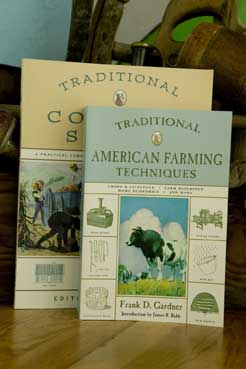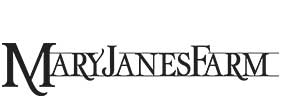 News from the Book World: from Traditional American Farming Techniques In the past two decades since I first settled on my five acres at the end of a dirt road in Idaho, I’ve somehow managed to survive and call myself an “organic farmer.” My ability to stay put and pay my bills in those early years, when I was a single mother with two young children, went beyond dogged determination and stick-to-it-ness; farming, for me, became religion. In the last few years, whenever I encountered an obstacle and muttered to myself, “There must be a way”…to get this pasture looking better, to give better ventilation to my chickens, to take my two beehives that seem weak and combine them, to choose the perfect dairy cow … I’ve reached for “The Good Book,” this book in your hands that I call my “Farm Bible.” This epic manual was written in an era when almost all farmers in North America were still organic small-scale farmers; when four-fifths of the farms in the United States had a dairy cow out back and two-thirds still made their own butter; when cows grew up on abundant pastures, not corporate feedlots; when chickens were free-range, not caged; when eating a strict organic diet didn’t require a trip to a health-food store; when the best-tasting carrot was simply a carrot and not a “certified organic” carrot. And the other ten smaller books in this timeless series, books with titles like Barns & Outbuildings, Farm Appliances, Farm Conveniences, Harris on Pigs, and Handy Farm Devices, I righteously refer to as my “scripture” books. Daily farm life (including Sundays) on my piece of Eden went something like this: I’d find a new weed or bug or one of my fruit trees would get a cankerous eruption or my daughter’s pig would find a way out of its pen again and I’d say, “Run to the barn and get the scripture on fences.” Scripture?! Farming for me has, no doubt, been an act of faith. So much so that rapture, farm romance, and humor were the only way to keep going at times. This book, Traditional American Farming Techniques, has it all and more and is still a ready reference for the modern-day organic farmer. (It’s easy enough to ignore the brief chapter on insecticides and the occasional mention of the then-newfound wonder, arsenic—the very beginning of an industry that would someday give us farmers a challenge far greater than the vagaries of weather and the availability of water.) And for sure, some of it is nostalgic novelty. I’m not likely to build a farm lime kiln, even though for two winters I did use a window box instead of a refrigerator. The instructions for creating a window box in this book are not only doable, the drawing itself is worthy of framing. If you love old line drawings and photos, this book is for you. And when it comes to gender, it’s definitely outdated. In 1916, women were “farm housewives.” Ninety years later, we’re the fastest growing group of people buying and operating small farms. While the number of American farms has dropped 14 percent in the last twenty-five years, the number of farms run by women has increased 86 percent, according to the U.S. Department of Agriculture. But even the outdated gender stuff serves a useful purpose—a reminder that we womenfolk have come a long way! For example, a textile and clothing expert in the chapter on Home Economics says farm women must do “the planning, the buying, perhaps the making, as well as care for the clothes”—aka shopping, sewing, and laundry. Our 1916 expert warns us: “The ball gown is immodest if worn on the street, and the bathing suit shocking in the parlor.” So from hogs to handiwork, hearth to home, everything “4-H” you’ll need to run a farmstead is here—things like how to build up your soil or how to deal with pernicious weeds and insect pests using down-home methods that still work today. It was here that I read about “sweeping” a field every ten days to control thistle. We visited an old John Deere bone yard, brought home and then repaired a retired sweep, hooked it up to our tractor and that was the end of thistle in an entire two-acre field. Afterwards, our sun-baked, worn-out soil needed rebuilding. Again, this book gave me new ideas for how to store and handle manures, make them go further, and kick-start the rebirth of tired soil with old-fashioned soil amendments ranging from benign supplements like lime and phosphate rock to organic regulars like wood ash and manure. And my favorite section? How to make better butter—both my lineage and my drug of choice! The ultimate in farm delicacies is perfectly ripened butter made using the cream you’ve coaxed from the udder of your very own cow (a farm pet as adorable as a clucking hen that you’ve trained to help with breakfast). Speaking of pets, we still joke about the captioned photo “Hogging Down Corn” every August when our corn patch ripens. In 1916, it meant turning loose your pet swine onto your cornfields after you’ve “downed” (harvested) the stalks, a form of natural rototilling. For us, it means eating nothing for dinner but fresh, hot ears of corn cooked on a campfire and then brushed with melted butter using bunches of fresh, bundled sprigs of rosemary as brushes. There are tried-and-true techniques for improving pastures and meadows; making hay by hand; even details on how to hand-cure alfalfa for maximum protein, the perfect tip for small farmers without access to a lot of working capital. For fruit lovers, everything from apples to pomelos is discussed in detail. Did you know that strawberries can be a good companion ground-cover crop to peach trees? Or that pears will grow too fast if planted in soil that is fertile? (In other words, if you have a troublesome clay area, plant a pear tree.) Beyond fruit trees, the discussion on ornamental trees is divided into those best suited for lining lanes, those for lawns, screens, hedges, and windbreaks. When it came time for my son to take over the milking of my cow “Chocolate,” I assigned him some reading material from the library in our barn that included the chapter on Dairy Herd Management. The description on how to manipulate a cow’s “glands” using the Hegelund method, thought in 1916 to produce more milk, is still the best description I’ve come across. In perfect detail, the three stages of manipulation are detailed: “When no more milk is obtained by the first manipulation, the hind quarters are milked by placing a hand on the outside of each quarter, likewise with fingers spread and turned upward, but with the thumb just in front of the hind quarter. The hands are lifted and grasped into the gland from behind and from the side, after which they are lowered to draw the milk.” Typical of the detail found in this book, a total novice could be sitting by the side of a cow for the first time, book in hand, and learn how to milk a cow or goats and sheep for that matter. For seed-savers, there is extensive information on selectively breeding varieties perfectly adapted to your locale. And for zealots rapturous about heirloom varieties, there are details on seed saving. Who would have thought back then that by the turn of the century we would save seed not only for economic reasons but in a desperate attempt to save certain varieties from extinction? Seed saving and planting heirloom seeds has become a deeply spiritual act—one that has converted thousands of forward-thinking gardeners and farmers into hellfire-and-brimstone evangelists. If you’re a land-poor farmer type longing for your place in the country, take heart—a new kind of farm is on the horizon, and the demand for local, hands-on food, or “food with a face,” is rising. New kinds of markets are opening up. Consumers are listening and shopping more with their hearts instead of their pocketbooks. The value of food has taken on a new meaning. I had a conversation recently with a bookkeeper that might prove helpful to anyone lusting for land. (I’ve never met a person yet who hasn’t, at some point in their life, had a farm fantasy.) A wannabe farmer in her early fifties, she is constantly on the prowl for the perfect piece of land. She’s also a watercolor artist. Her search for land seemed to be taking its toll on her artwork, her weekends off, her inner calm. I offered this bit of advice: If you can’t yet cultivate your own back forty, cultivate instead your farm fantasies. Give them free reign, letting them grow with abandon, like weeds gone wild. With books like this one, they can be a sensory journey almost as good as being there. In the meantime, do your homework; plant a garden. Learn how to eat zucchini a hundred different ways! And while you’re waiting for your farming stars to align, sit back and enjoy the journey, read, take notes, buy tools. Giving full reign to the farmstead life you hold in your heart starts here in your hands. |


